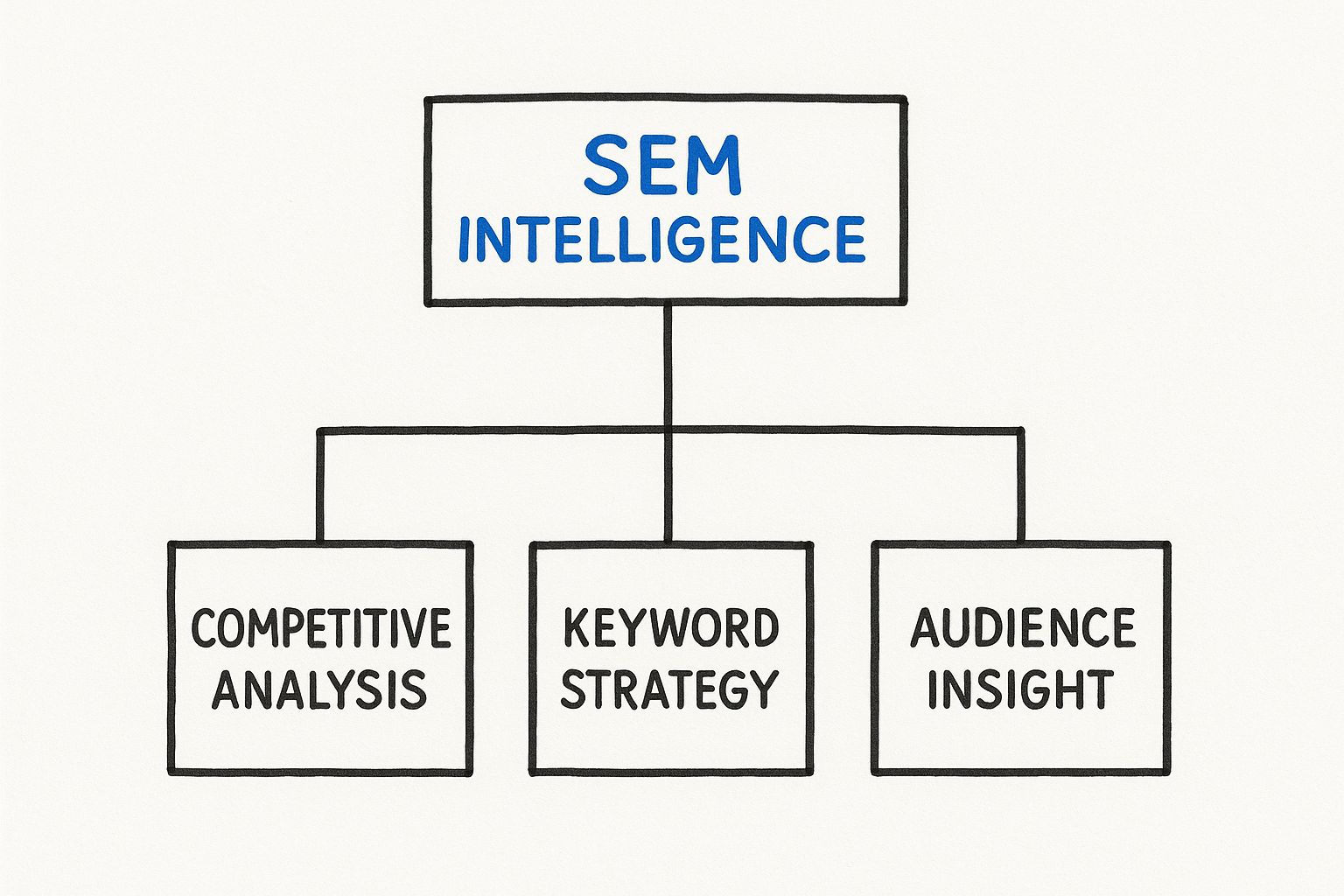Boost Your Strategies with Search Engine Marketing Intelligence

Maxime Dupré
10/10/2025

Search engine marketing intelligence is all about gathering and making sense of search data so you can make smarter marketing decisions. It’s a blend of insights from both your paid ads (PPC) and your organic search efforts (SEO). The goal? To see exactly what your competitors are doing, get inside the heads of your audience, and sharpen your own performance.
Think of it as your strategic command center for winning on Google.
What Is Search Engine Marketing Intelligence
True search engine marketing intelligence isn't just about collecting data points. It’s about turning a sea of raw numbers into a clear, actionable roadmap for growth. We’re moving past looking at isolated metrics like click-through rates or keyword rankings in a vacuum. Instead, we’re building a complete picture of the entire search environment. When you understand the "why" behind the numbers, you can start to predict market shifts and counter competitor moves with confidence.
This approach is non-negotiable in a market where one search engine reigns supreme. Google processes nearly 99,000 searches every single second, which means the amount of data available to us is almost overwhelming. This dominance means your intelligence work will naturally focus on its ecosystem, a reality underscored by the latest market share numbers.
The Core Pillars of SEM Intelligence
To get a handle on all this data, we break the process down into a few core components. These pillars don't work in isolation; they support each other to give you a complete view of your performance and opportunities.
This diagram shows how these foundational pieces fit together to create a solid SEM intelligence strategy.

As you can see, competitive analysis, keyword strategy, and audience insight are the pillars holding everything up. Each one informs the others, creating a powerful, continuous cycle of learning and improvement.
The real goal here is to shift from making reactive adjustments to building a proactive strategy. You stop just responding to a drop in rankings and start anticipating the competitor's move that caused it—and you have a counter-move ready to go.
To bring this all together, we can summarize these core components in a simple table.
The Four Pillars of SEM Intelligence
This table breaks down the core components that form a complete Search Engine Marketing Intelligence strategy.
| Pillar | Focus Area | Key Questions Answered |
|---|---|---|
| Competitive Intelligence | Analyzing rival SEO & PPC strategies | Who are my real search competitors? Where are they spending their ad budget? What keywords are they winning? |
| Keyword Intelligence | Identifying and prioritizing valuable search terms | What are my customers actually searching for? Which keywords have the highest commercial intent? Are there any untapped opportunities? |
| Audience Intelligence | Understanding user behavior and intent | What problems are my customers trying to solve? What kind of content resonates with them? How does their search journey look? |
| Performance Intelligence | Measuring impact and ROI | How are my search efforts impacting business goals? Which campaigns are driving the most revenue? Where should I allocate my budget for the best return? |
By consistently monitoring these four areas, you gain a holistic understanding that allows you to make strategic, data-backed decisions instead of just guessing.
This integrated view helps you do several critical things:
- Identify Competitor Weaknesses: Pinpoint where rivals are pouring their ad budget or, more importantly, which valuable keywords they’re completely ignoring. Our guide on what is competitive intelligence dives much deeper into this process.
- Discover Audience Needs: Go beyond what you think your customers want. Analyzing real search queries and trends shows you what they're actually looking for.
- Optimize Your Budget: Put your money where it will have the biggest impact. By focusing on the channels and keywords that deliver the highest return, you stop wasting resources.
- Measure True Performance: Finally, you can draw a straight line from your search metrics to tangible business outcomes like new leads, sales, and bottom-line revenue.
Decoding Your Competitors' Digital Playbook

Great search engine marketing intelligence really starts with a deep dive into what your competitors are doing. Think of it like being a detective, piecing together clues from their public search activities to figure out the strategy that’s getting them results. This isn't just about making a list of their keywords; it's about reverse-engineering their entire game plan.
To do this right, you have to look at their organic and paid search efforts as two sides of the same coin. A competitor's paid campaigns, for example, tell you exactly which keywords they see as most valuable for making money. The language in their ads shows you which pain points and selling propositions they've found work best for getting people to click.
At the same time, their organic presence tells the story of their long-term content strategy and where they hold authority. By digging into their top-performing content, you get a clear picture of what topics connect with the audience and build trust. When you combine these insights, you get a complete, 360-degree view of how they position themselves in the market.
Uncovering SEO and PPC Strategies
To really get inside your competitors' heads, you have to master how to conduct competitor analysis and pull out strategic gold. This means looking at very specific pieces of their campaigns to understand their methods and spot openings for your own.
A great place to start is by dissecting their paid search funnel. Take a close look at their ad copy to see what emotional hooks and calls-to-action they rely on. Are they all about price? Features? Or are they focused on solving a single, nagging problem? That language tells you everything about their core message.
Then, click the ad and follow the user's path to their landing pages. Once you’re there, look at how they try to convert visitors. Are they using testimonials as social proof? Are there limited-time offers? Is the contact form simple and direct? Every single element is a calculated choice, and understanding those choices can help you make your own conversion funnels much sharper.
A competitor’s ad spend is a direct signal of their priorities. By tracking where they consistently invest their budget, you can identify the keywords and audience segments they value most, often revealing a blueprint for profitable campaigns.
Mapping their entire keyword universe is the next crucial step. This means finding not just the keywords they’re actively targeting, but also the ones they’re completely ignoring. These "keyword gaps" are pure gold—opportunities for you to grab market share with far less of a fight.
From Analysis to Actionable Insights
Gathering all this data is just the beginning. The real magic happens when you turn that raw information into a genuine strategic advantage. Your analysis should always end with a clear, actionable list of takeaways you can immediately apply to your own marketing.
Here’s how you can turn what you've found into real-world actions:
- Pinpoint Winning Ad Angles: If a competitor's ads consistently talk about a specific benefit that you also offer, try testing a similar angle in your own campaigns. You can adapt their successful message to fit your own brand voice.
- Find Content Gaps: Discover high-intent keywords that your competitors aren't even trying to rank for with their content. Creating great articles, guides, or tools around these topics is a fantastic way to pull in valuable organic traffic.
- Benchmark Performance Over Time: Competitor analysis isn't a one-and-done task. You need to consistently track their keyword rankings, estimated ad spend, and new ad creative to catch shifts in their strategy and react quickly.
By systematically breaking down what your rivals are doing, you stop guessing and start building a strategy based on solid data. This ongoing process of search engine marketing intelligence is what ensures you not only keep up with the competition but also find clever ways to get ahead of them.
Building Your SEM Intelligence Toolkit

Real search engine marketing intelligence doesn't come from guesswork or hunches. It comes from having the right technology to gather, slice, and act on data. Think of building your toolkit like assembling a crew of specialists; each tool has a very specific job to do, uncovering different pieces of the puzzle. You don't need a hundred different subscriptions, but you do need a smart, curated set of platforms.
This is your digital command center. The goal is to piece together tools that give you a 360-degree view of the search landscape, from what your biggest rival is spending on ads all the way down to how your own content is performing.
Core Components of Your Tech Stack
To put together a truly effective toolkit, you should focus on three main software categories. Each one gives you a different lens to look at the market through. When you combine their insights, you get a much clearer, more complete picture of your competitive environment.
These are the essentials:
- All-in-One SEO & SEM Platforms: These are the Swiss Army knives in your arsenal. Platforms like Semrush or Ahrefs are built to track keyword rankings, dissect backlink profiles, and run technical site audits. They give you the foundational data for both your organic and paid search strategies.
- Specialized PPC Intelligence Tools: While the all-in-one platforms touch on paid search, dedicated tools like SpyFu or Similarweb go way deeper. They are masters at uncovering competitor ad copy, estimating their monthly ad spend, and reverse-engineering their paid funnels. This is where you get the nitty-gritty details on their PPC game plan.
- Analytics and Performance Platforms: This group is headlined by essentials like Google Analytics 4. Their sole purpose is to connect your search efforts to actual business results. They track how users behave on your site, where conversions happen, and what revenue is generated, proving the true ROI of your campaigns.
The best toolkits aren't always the most expensive. They're the ones where the tools work together, letting you cross-reference data from different sources to confirm your theories and build a smarter strategy.
Choosing the Right Tools for Your Goals
With a sea of options out there, the trick is to pick tools based on the specific intel you actually need. A long list of features means nothing if it doesn't solve a problem for you. Instead, you need to understand the job of each tool and how it aligns with what you're trying to accomplish. For a closer look at this, our guide on paid search intelligence offers some great tips for PPC-specific strategies.
So, how do you decide where to invest your budget? This table breaks down the tool categories to help you map your needs to the right solution.
Comparison of SEM Intelligence Tool Categories
| Tool Category | Primary Function | Key Intelligence Provided | Example Platforms |
|---|---|---|---|
| All-in-One Platforms | Organic and paid search monitoring | Keyword rankings, backlink analysis, competitor traffic estimates, top content | Semrush, Ahrefs, Moz Pro |
| PPC Intelligence | Deep competitor ad analysis | Ad spend estimates, historical ad copy, landing page strategies, keyword bidding history | SpyFu, Similarweb, iSpionage |
| Web Analytics | On-site performance tracking | Conversion rates, user engagement, traffic source attribution, audience demographics | Google Analytics 4, Matomo |
By thoughtfully combining platforms from each of these categories, you’re no longer just guessing—you’re operating with a real competitive advantage. Your toolkit becomes the engine that powers your entire search engine marketing intelligence program.
Understanding Modern Search Behavior and Trends
To really nail search engine marketing, you have to remember you're dealing with people, not just algorithms. The way we all search is constantly in flux, shaped by new tech and our own changing expectations. If you want to stay ahead, you have to look past simple keywords and get to the heart of why someone is searching in the first place.
This is especially true on our phones. Think about it: in the United States, over 60% of Google searches now happen on a mobile device. This isn't just a small shift; it completely changes the game. People searching on their phones tend to be more exploratory, often rewording their queries and taking a bit longer to decide. That's a behavior we, as marketers, need to understand and adapt to. You can dig deeper into these Google search statistics and their implications on semrush.com.
The Rise of Conversational Search
We don't search like robots anymore. Gone are the days of typing choppy phrases like "best coffee shop Austin." Now, we search the same way we talk. We ask full questions, like, "Where can I find a quiet coffee shop near me with good wifi?" This move toward natural, conversational queries is a direct result of voice assistants and smarter search engines.
So what does this mean for your keyword strategy? It means you can't just fixate on short, high-volume keywords. You have to start targeting the actual questions your audience is asking. More often than not, that involves creating more in-depth content that provides a direct solution to a very specific problem.
By optimizing for conversational queries, you're not just trying to rank for a keyword; you're positioning your brand as the definitive answer to a user's specific problem. This builds authority and trust in a way that traditional keyword stuffing never could.
Deciphering User Intent and New Technologies
A huge piece of this puzzle is getting a real grip on user intent. This is one of the most vital skills for any SEM intelligence strategy. A fantastic resource for this is Mastering Search Intent Optimization, which really gets into the weeds of the topic. Intent is all about the "why" behind the search—is the person trying to learn something, compare products, or make a purchase right now?
This has become even more important with the rollout of features like Google's AI Overviews. These tools try to answer questions right on the search results page, which can completely change how users find information. To earn that click, you need to provide the most thorough, authoritative, and well-organized answer out there. It also means keeping an eye on how these technologies affect your backlink profile, which is still a massive ranking signal. For a refresher, take a look at our guide on how to find backlinks on Google.
Ultimately, your strategy has to do double duty: you need to fight for those traditional rankings and make sure you're visible within these new AI-powered answer formats.
Adapting Your Strategy for Global and Local Markets
 A search strategy that crushes it in one market can completely bomb in another. This is where real search engine marketing intelligence proves its worth, showing you exactly how to tweak your approach for global expansion or local domination.
A search strategy that crushes it in one market can completely bomb in another. This is where real search engine marketing intelligence proves its worth, showing you exactly how to tweak your approach for global expansion or local domination.
Let's be honest: a one-size-fits-all strategy just doesn't work. What captures attention in New York will likely fall flat in Berlin or Tokyo. You have to adapt.
Success on a bigger stage means going way beyond simple translation. This gets to the heart of SEO localization—retooling your keywords, content, and entire strategy to fit local cultural norms and even different search engines. For example, your intelligence might reveal that while you’re focused on Google, your competitors are cleaning up on Yandex in Eastern Europe or Baidu in China.
Conquering International Search
Going global means speaking your customers' language, both literally and figuratively. The data on this is crystal clear: localization gets results.
Consider that 75% of users flat-out prefer buying products in their native language. It’s no surprise that companies nailing their localization efforts often see organic traffic jump by as much as a 70% in the first year. You can dig into more data like this in the latest SEO statistics on searchatlas.com.
This isn't just about swapping words. It’s about getting inside the cultural details that shape how people search for things online.
One of the biggest blunders we see is assuming a direct keyword translation carries the same intent. SEM intelligence is your tool for finding the unique phrases, slang, and cultural touchstones that make your message feel like it was written just for them, not just translated for them.
Dominating the Local Arena
If your focus is more boots-on-the-ground in a specific city or region, SEM intelligence is just as critical. It helps you pinpoint the high-value, location-based searches that scream "I'm ready to buy." Think "coffee shop near me" or "emergency plumber in Brooklyn."
To win the local game, your intelligence gathering should zoom in on a few key areas:
- Google Business Profile Optimization: What are your top local competitors doing with their profiles? Analyze their categories, attributes, and posts to see what’s actually driving calls and foot traffic.
- Local Citation Management: Find out which online directories your competitors are listed in. Your goal is to be everywhere they are (and more), with perfectly consistent business information across the board.
- Location-Based Keyword Targeting: Uncover the specific keywords people are using with local tags, like city names or neighborhoods. Targeting these is how you intercept searchers who are ready to act now.
By applying this kind of intelligence at both the macro (global) and micro (local) levels, you ensure your strategy is sharp, relevant, and built to perform, no matter where your customers are.
Let SEM Intelligence Power Your Entire Business
Search engine marketing intelligence truly shines when its insights break out of the marketing department's four walls. It shouldn't be a siloed tool for running ad campaigns. Instead, think of it as a core ingredient in your company's strategic recipe, feeding crucial information to teams across the board.
Imagine your product team tapping into real-time keyword trend data to shape their next big feature. A sudden spike in searches for a specific problem your product could solve? That's not just data—it's a direct signal from the market, validating an idea before you sink a single dollar into development.
Arm Your Sales and Product Teams with an Unfair Advantage
This kind of intelligence is a game-changer for other departments. Your sales reps, for example, can walk into conversations armed with competitor insights, ready to handle objections and pinpoint exactly where your solution comes out on top.
- For Sales: Hand them data on a rival's ad copy and latest promotions. Suddenly, they know precisely what offers a prospect has seen and can frame your value in a much more compelling way.
- For Product: Share reports on how your audience actually searches. Revealing the exact language people use to describe their pain points is gold for building products and user experiences that just click.
The real win is when SEM intelligence becomes a continuous feedback loop, not just a one-off report. It’s a living cycle of learning, adapting, and innovating that drives growth for the whole company, not just one team.
Getting buy-in from leadership depends on how you frame it. Don't just show them keyword charts; connect the dots. Show them how search data directly impacts the things they care about most—revenue, market share, and happy customers. That’s how you get their attention.
Got Questions About SEM Intelligence? We've Got Answers.
Jumping into the world of search intelligence can feel a little overwhelming, and it's natural to have questions. Let's clear up some of the most common ones so you can put these ideas into practice.
Is SEM Intelligence Just Another Name for SEO?
Not quite, but they are definitely related. Think of it like this: SEO (Search Engine Optimization) is the hands-on work you do to get your website to show up higher in the organic, unpaid search results. It's a critical piece of the puzzle.
Search engine marketing intelligence, on the other hand, is the bigger picture. It's the process of gathering and analyzing data from both your SEO efforts and your paid search campaigns (like Google Ads). It brings everything together to give you a complete view of the search landscape, from what competitors are bidding on to how users are behaving across the board.
How Often Should I Be Checking My Intelligence Reports?
This really depends on how fast your industry moves. If you're in a highly competitive space where things change daily, a weekly peek at competitor ad copy and keyword bids is a good idea. For most businesses, though, a deep dive once a month or every quarter will keep you ahead of the curve.
The real goal isn't to stick to a rigid schedule but to build a habit of continuous monitoring. You can set up automated alerts for big moves your competitors make. That way, you can react when it matters without getting bogged down in daily manual checks. The aim is to be informed, not buried in data.
Can a Small Business Actually Use This Stuff?
Absolutely. In fact, for smaller businesses, SEM intelligence can be a secret weapon. You might not have the massive ad budget to go head-to-head with the big corporations, but you can definitely out-think them.
Intelligence helps you spot opportunities they've overlooked, like niche keywords with low competition or weak spots in their ad strategy that you can take advantage of. It’s all about using the resources you do have in a much smarter, more targeted way. This isn't just a game for the big players; it's for anyone who wants to compete more effectively.
Ready to stop guessing and start winning? ChampSignal delivers actionable competitor alerts directly to you, so you can uncover growth opportunities without hours of manual research. Get started with a free trial at champsignal.com and see what your competitors are really up to.
Get Started
Competitor Monitoring That Doesn't Suck
Spend under two minutes per week monitoring your competitors. Receive only the information that matters.
Join other SMBs on top of their competitors.

